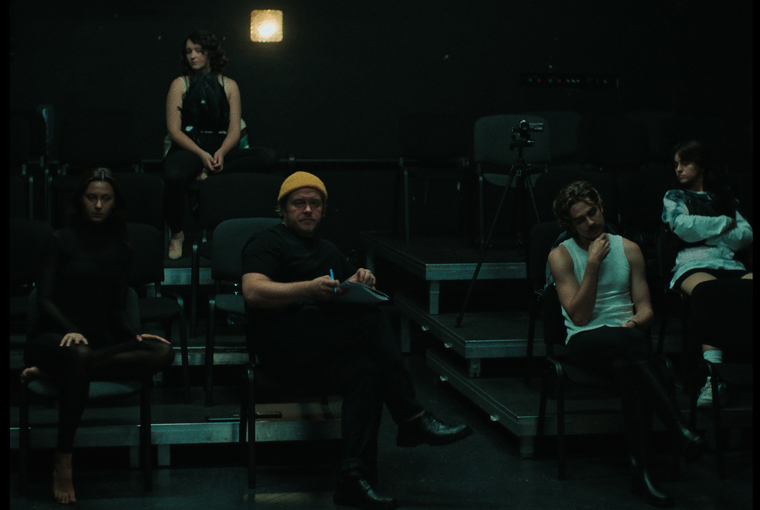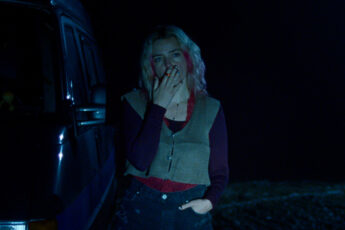A Teacher’s Favorite Pet
Korek Bojanowski’s Loss of Balance (Utrata równowagi, 2025)
Vol. 157 (September 2025) by Antonis Lagarias
Classroom hierarchies place teachers in a position of authority from which they can exert a powerful influence on a student’s mind and feelings. Seeing an authority figure expressing their trust and hope changes a student’s self-perception and helps them unlock their full potential. On the other hand, negative feedback, punishment, or indifference may cause anxiety and pain. Such classroom dynamics have been depicted widely in cinema, especially in coming-of-age narratives focused on how young people evolve and mature through meaningful or destructive interactions with mentors. Yet similar dynamics and dangers also characterize certain professions with complex hierarchical rules.
In the art world, authority has long been abused – be it the authority of a teacher or that of a director. The numerous testimonies of the #MeToo movement exposed a long history of silenced stories of sexual violence, mainly against women. In addition to sexual assault, many of these stories describe calculated mechanisms of psychological warfare, including manipulation, gaslighting, and verbal humiliation. The #MeToo narrative is ultimately about power and how it is exercised by those who hold it against those who do not.
Telling the art world’s stories of violence and abuse through film often proves difficult. For instance, Todd Field’s Oscar-nominated Tár did so by changing the expected gender roles, placing abusive power in the hands of a lesbian orchestra conductor played by Cate Blanchett. “Power is not about gender,” Field claims, a view that, while arguably true, also neglects the (patriarchal) processes that have produced these very positions of authority and their lack of accountability. It is not surprising that feminist journals were less enthusiastic about a film built on the assumption that the life of powerful lesbian women “is no different from that of a straight man.”1 In reality, very few women ever get the opportunity to become orchestra conductors in a field dominated by men, let alone reach a position where they could easily prey on young aspiring talents.2 That power corrupts is a truism that envisions anyone turning into an aggressor once in a position of power. Used in vague or moralizing ways, this narrative is more fit to dissipate responsibilities and once again pronounce “human nature” guilty, than to challenge the structures of authority and power.
Korek Bojanowski’s feature Loss of Balance walks a thin line in telling the story of a victim-turned-perpetrator. The film centers on Maja (Nel Kaczmarek), a young student at Poland’s “most prestigious” drama school as she and her classmates prepare their final play before graduation. This production is pivotal to their professional futures, so the administration brings in acclaimed director Jacek (Tomasz Szuchardt) to oversee the project. From their first meeting, Jacek takes a special interest in Maja and decides she will play the leading role, Lady Macbeth. Maja disregards her initial mistrust and, as time goes by, surrenders herself to Jacek’s guidance. Days before the performance, however, Jacek deems her acting skills unsatisfactory and replaces her with a fellow actress. Betrayed, and unable to understand why, Maja embarks on a quest for vengeance.
If the narrative sounds familiar, it is because it reflects dynamics found all around drama schools and the world of young theater acting. Directors, who are often also teachers in these schools, are not only respected figures because of their experience, but can quite literally “make or break” an actor’s future in a field dominated by micropolitics and personal connections where “everyone knows everyone.” A mix of fear and admiration sustains this system of subordination and control, which feeds on young actors’ thirst for recognition. In the film, Jacek “chooses” Maja because he “sees” her potential, and “guides” her so she will become a better actress. Maja, in turn, accepts to dive into Jacek’s world even if that means abandoning her lover and friends, all in the name of art. As Bojanowski told journalists, Loss of Balance seeks to avoid a didactic and simplistic narrative.3 Jacek is therefore not overtly aggressive. Shown through the actors’ perspective, at times he comes across as a misunderstood, if harsh, artistic genius. After all, his manipulative methods do seem to produce results. Maja feels reborn and regains a sense of control over her life that previously felt disappointing. Later, when Maja tries to warn her classmates of Jacek’s methods, the group rejects her, believing that their improved acting performance matters more than the psychological harm it involves. At the end, Maja chooses to fight against Jacek, the school administration, and her classmates, not to denounce the violence she endured but to regain her place on the theater stage. The film ends on an even more ambiguous note, as the final scene suggests that it may have been Jacek’s plan all along to provoke Maja’s artistic transformation through rejection, even at the cost of discrediting himself. After all, a true mentor’s dream is to die symbolically and make room for the new.
Staging yet another narrative of abuse in the theater, only to ultimately focus on whether the ends justify the means, feels outdated to say the least. The notion that suffering produces a performance so captivating and “true” that it justifies the underlying violence is another truism that persists in both art schools and their cinematic counterparts. While the film acknowledges the problematic nature of this logic, it seems less interested in deconstructing it than presenting its supposed nuance. Thus, Maja’s desire to be the main protagonist rather than collaborate with her team, or Jacek’s ability to shape better actors through pain, are treated as unquestioned, if regrettable, facts about theater. As a result, the film sidesteps the most crucial questions: how are these positions of power established? Why are they so tempting? And how can we limit their harm?
Polish theater has experienced its own wave of #MeToo testimonies since 2019.4 There is still a long way to go to carefully document cases of violence, identify perpetrators, and dismantle the mechanisms that have enabled them, not only in Poland but across European theater. In light of this reality, if stories of abuse are to become film material, their purpose should no longer be to expose the “dark side” of passion and desire for stage performance, as numerous films have done in the past,5 but to help envision alternatives. As the #MeToo experience shows, systemic problems cannot be solved by personal rebellion alone. What is needed instead is to openly reject the myth of ingenious creators, form networks of support and solidarity, and devise different creative processes with looser hierarchies. It is difficult to see how Loss of Balance can contribute to these conversations. To be clear, overtly militant filmmaking showing the world as it “should be” has its own limitations. However, a story where everyone is solely driven by individual ambition, and a young woman is transformed through the ambiguous charisma of a (violent) man, feels not only redundant, but increasingly irrelevant to the realities of the art world.
- Beller-Tadiar, L. (2023, January 25). The lesbian allure and colonial unconscious of Todd Field’s Tár. Another Gaze. https://www.anothergaze.com/lesbian-allure-colonial-unconscious-todd-fields-tar/ ↩︎
- Duchen, J. (2025, February 28). ‘One audience member told me I belonged in the kitchen, making children’: Why are there still so few female conductors? Classical Music. https://www.classical-music.com/articles/female-conductors ↩︎
- Caruso, V. (2025, July 1). Interview: Korek Bojanowski, director of Loss of Balance. Cineuropa. https://cineuropa.org/en/interview/480805/ ↩︎
- Jakimiak, A. (2020). Theatre after #MeToo: Sexual abuse and institutional change in Poland. Contemporary Theatre Review. https://www.contemporarytheatrereview.org/2020/theatre-after-metoo-sexual-abuse-and-institutional-change-in-poland/ ↩︎
- See for instance Darren Aronofsky’s Black Swan. ↩︎




Leave a Comment